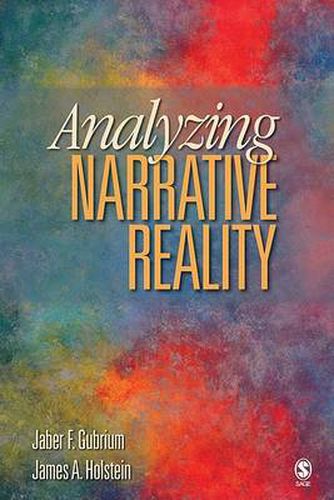Readings Newsletter
Become a Readings Member to make your shopping experience even easier.
Sign in or sign up for free!
You’re not far away from qualifying for FREE standard shipping within Australia
You’ve qualified for FREE standard shipping within Australia
The cart is loading…






Narrative Ethnography expands the focus of narrative analysis to the broader realm of what is called narrative practice. Typically, contemporary narrative analysis focuses on the internal organization of stories. Authors Jaber F. Gubrium and James A. Holstein take up a new, yet related, topic: the social organization of narrative practice. Specifically, they argue that researchers must begin to systematically consider the contexts, circumstances, and resources that shape the production of narratives. The authors provide both the analytic and procedural dimensions of narrative ethnography. The title and term onarrative ethnographyo already is directive and the authors have been developing this vocabulary for decades. Other analytic terms form the basis for chapters and sections of the book: narrative horizons, narrative linkage, narrative editing, narrative space, narrative exposure, narrative control, narrative authenticity, and narrative embeddedness, among others. The book is organized into three sections. The introductory chapters of Part I develop in detail the rationale for, and historical background of, narrative ethnography.Part II focuses on various sensitizing concepts, their procedural contours, and related illustrative material. Part III is comprised of summary chapters that take up broader representational and explanatory issues, such as how to approach the study of narrative practice in relation to the challenges of postmodern, global, and postcolonial perspectives. Narrative Ethnography can be used as a main text in graduate research methods courses across the social sciences and human service professions in which ethnographic and narrative practice are emphasized.
$9.00 standard shipping within Australia
FREE standard shipping within Australia for orders over $100.00
Express & International shipping calculated at checkout
Narrative Ethnography expands the focus of narrative analysis to the broader realm of what is called narrative practice. Typically, contemporary narrative analysis focuses on the internal organization of stories. Authors Jaber F. Gubrium and James A. Holstein take up a new, yet related, topic: the social organization of narrative practice. Specifically, they argue that researchers must begin to systematically consider the contexts, circumstances, and resources that shape the production of narratives. The authors provide both the analytic and procedural dimensions of narrative ethnography. The title and term onarrative ethnographyo already is directive and the authors have been developing this vocabulary for decades. Other analytic terms form the basis for chapters and sections of the book: narrative horizons, narrative linkage, narrative editing, narrative space, narrative exposure, narrative control, narrative authenticity, and narrative embeddedness, among others. The book is organized into three sections. The introductory chapters of Part I develop in detail the rationale for, and historical background of, narrative ethnography.Part II focuses on various sensitizing concepts, their procedural contours, and related illustrative material. Part III is comprised of summary chapters that take up broader representational and explanatory issues, such as how to approach the study of narrative practice in relation to the challenges of postmodern, global, and postcolonial perspectives. Narrative Ethnography can be used as a main text in graduate research methods courses across the social sciences and human service professions in which ethnographic and narrative practice are emphasized.